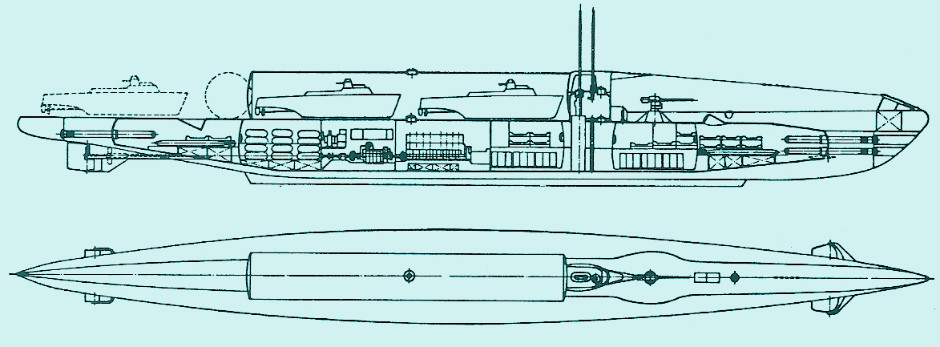
Dating from the arms race of the mid-late 1930s the German Type-IIIA was an extremely unusual design. It included a large dry shelter which could accommodate two motor launches in tandem. The hangar was carried on the aft casing behind the conning tower and extended almost to the stern. The boats would have to be launched one at a time because the shelter would have to be closed and sealed between launches. The procedure would be to surface the submarine, open the shelter, pull out a boat onto a rail or cradle on the rear casing and then close the shelter gain. Only then would the submarine be able to start submerging so that the boat floated free. Alternately a crane could be used but this does not seem to be part of the design. It's unclear how the boat would be brought aboard again although a likely approach would be to winch it up the stern whilst the boat was awash.

Original artwork. CLICK for HIGH-RESOLUTION image.

The Type-IIIA was not built. With retrospect it seems an incredibly dangerous to have such a large hangar because if it flooded whilst it was submerged it might not have enough reserve buoyancy to surface, and if it did it might capsize.
The ultimate book of Special Forces subs Covert Shores 2nd Edition is the ONLY world history of naval Special Forces, their missions and their specialist vehicles. SEALs, SBS, COMSUBIN, Sh-13, Spetsnaz, Kampfschwimmers, Commando Hubert, 4RR and many more.
Check it out on Amazon
CARGO
The Type-IIIA was designed to carry two SL-Boats. These were 1930s small torpedo boats armed with two heavyweight (21"/533mm) torpedoes in the stern. It was intended to use these to lay mines rather than as torpedo boats.

*SL-Boot. Source s-boot.net
Length: 12.5m
Beam: 3.46m
Weight: 11.5 tons
Crew: 7
Armament: 2 x 21"/533mm torpedoes, 1 x 15mm machinegun
Poweplant: 2 x Daimler-Benz MB 507 Diesels 1100 PS driving two propellers
Speed: 38kts
Builder: Dornier-Werft, Friedrichshafen

